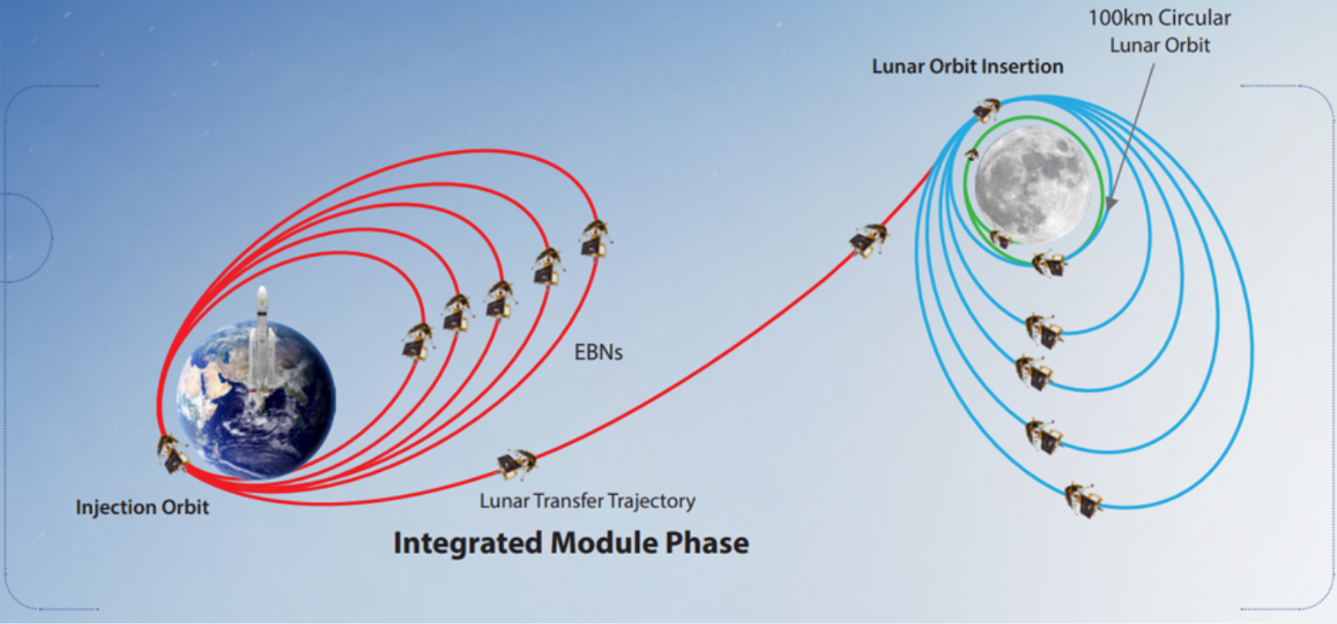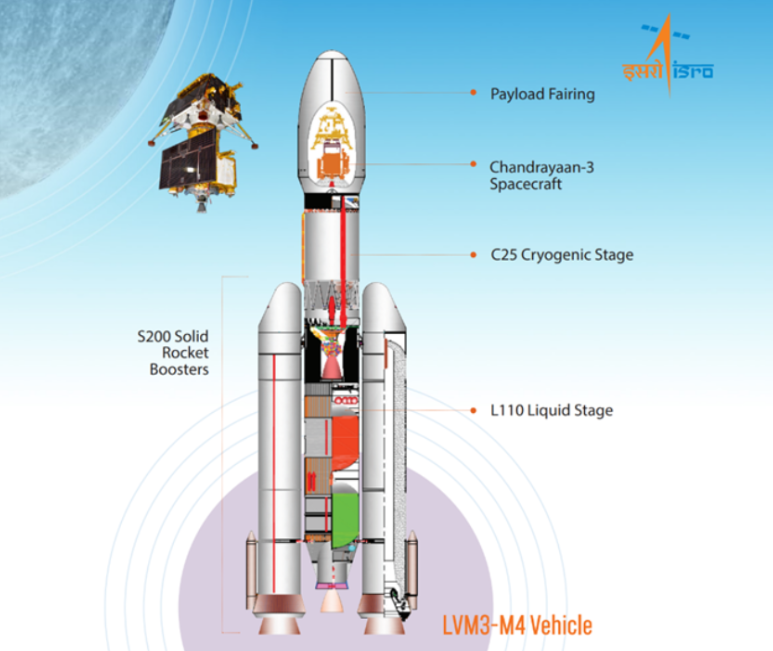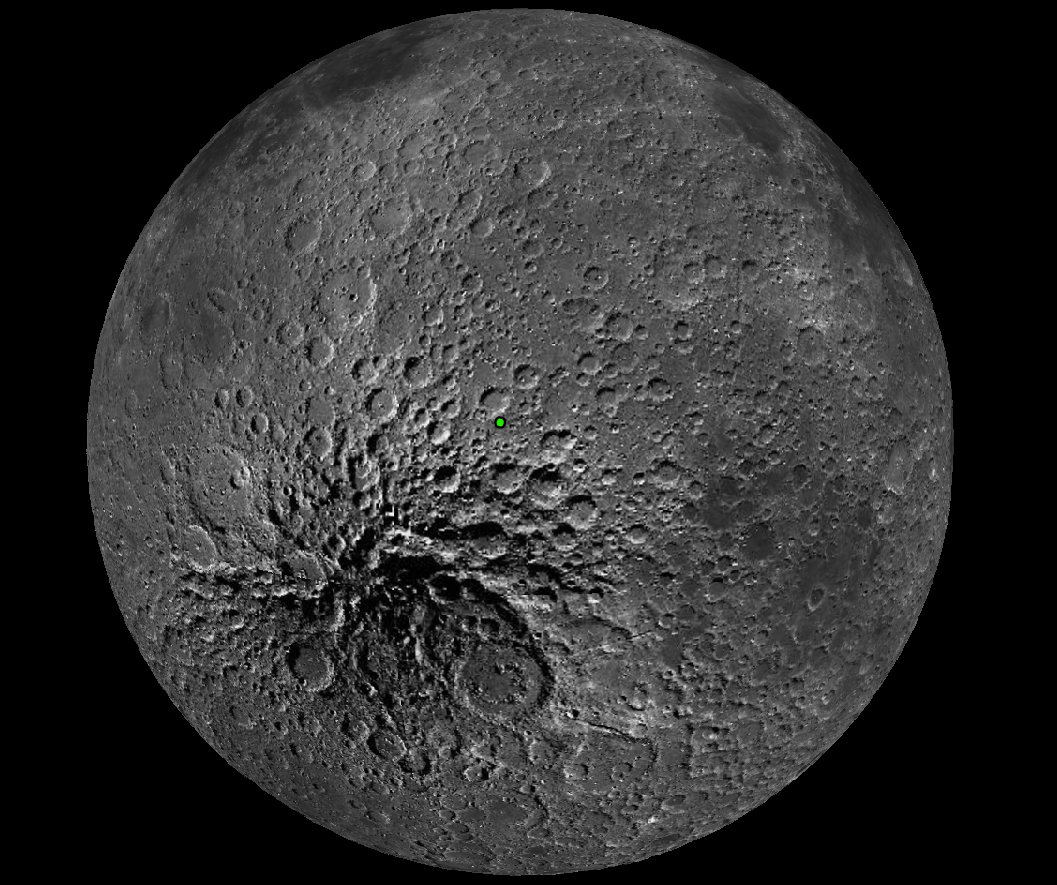Throughout history, humanity has been captivated by the moon, one of the most enchanting celestial objects in the universe. Intrigued by the enigmatic white orb hanging in the sky, we embarked on space missions driven by our innate curiosity to unravel its mysteries. The Soviet Union’s Luna 2 spacecraft was the first to reach the lunar surface in 1959. Many space missions were dedicated to the moon landing as part of the space race between the United States and the Soviet Union, including the famous Apollo 11, the first human step on the moon, in 1969.
India has firmly established its lunar quest by launching Chandrayaan 1 (on October 22, 2008), Chandrayaan 2 (on July 22, 2019), and Chandrayaan 3 (on July 14, 2023) to the moon. Let us have a peek at ISRO’s most recent accomplishment, Chandrayaan 3. On July 14, 2023, at 14:35 IST, Chandrayaan 3 was launched aboard the LVM3 M4 rocket from the Satish Dhawan Space Centre.
Objectives of Chandrayaan 3
- Getting the lander a safe and soft landing on the surface of the moon.
- Observing and demonstrating the capabilities of the rover on the lunar surface.
- Conducting scientific experiments to better understand the composition of the moon, including its chemical and natural elements, soil, and water.
Chandrayaan 3 aims to showcase its end-to-end capability in safe landing and roving on the moon’s surface. It specifically focuses on exploring areas that have been deprived of sunlight for billions of years, with a planned landing at the moon’s south pole on August 23, 2023. This endeavor poses a significant challenge due to the tough terrain and extremely low temperatures present in the south pole region. If successful, Chandrayaan 3 will make India part of an exclusive group of countries, including the US, China, and the former Soviet Union, that have achieved a soft landing on the moon. So, why target the south pole? Scientists believe that this region holds unique characteristics that offer potential for deep space scientific discoveries. There is a possibility of finding water ice at the south pole, and the rocks and soil in this area could provide valuable insights into the early solar system, as they have remained frozen for billions of years.
Layout and Path of the Mission

The mission begins by orbiting the Earth approximately 5-6 times in an elliptical cycle, gradually transitioning towards the lunar orbit. Following separation from the launch vehicle, the propulsion module and the lander embark on a month-long journey to reach the moon’s orbit, gradually ascending to an altitude of 100 km above the lunar surface. At this point, the lander module initiates its descent for a soft landing on the moon’s surface. Once a successful landing is achieved, the rover emerges from the lander module and utilizes its payloads to conduct studies of the moon’s surface.
Components of Chandrayaan 3
LVM3-M4 Vehicle
LVM3 serves as the operational heavy lift launch vehicle for ISRO. Chandrayaan 3, designated as the fourth operational mission (M4) of the LVM3 launcher, is responsible for carrying the necessary payload into space.

The payload of Chandrayaan 3 comprises three main components:
-
Propulsion Module:
The propulsion module facilitates the transportation of the lander and rover from the injection orbit around Earth to the lunar orbit at a distance of 100 km. Additionally, the propulsion module includes the Spectro-polarimetry of HAbitable Planet Earth (SHAPE) experiment. SHAPE aims to study Earth from lunar orbit, specifically focusing on spectro-polarimetric signatures in the near-infrared wavelength range. This experimental payload allows for the exploration of reflected light from smaller planets, providing insights into a variety of exoplanets that may have habitable conditions.

-
Lander Module - Vikram:
While the propulsion module stays in lunar orbit, the Vikram lander drops to the surface for a soft landing. It is box-shaped and equipped with four landing legs and four thrusters. It carries the rover and various instruments necessary for in-situ analysis. The operational lifespan of the lander and the rover is equivalent to one lunar day, which is approximately 14 Earth days. The payloads (those elements of the spacecraft/rocket/missile specifically dedicated to producing mission data and then relaying that data back to Earth) present on the lander include:
a. RAMBHA-LP (Langmuir Probe): This instrument measures the plasma density and its variations on the lunar surface.
b. ChaSTE (Chandra’s Surface Thermo-physical Experiment): Designed to assess the thermal properties of the lunar surface near the polar region.
c. ILSA (Instrument for Lunar Seismic Activity): Its purpose is to detect seismic activity in the vicinity of the landing site, aiding in the determination of the structure of the lunar crust and mantle.
d. Laser Retroreflector Array (LRA): This passive experiment contributes to the understanding of the dynamics of the Moon system.

These sensors are on the missile’s lander to ensure a safe touchdown: Laser Inertial Referencing and Accelerometer Package (LIRAP), Ka-Band Altimeter (KaRA), Lander Position Detection Camera (LPDC), Lander Hazard Detection & Avoidance Camera (LHDAC), Laser Altimeter (LASA), Laser Doppler Velocimeter (LDV), Lander Horizontal Velocity Camera (LHVC), Micro Star sensor, Inclinometer & Touchdown sensors
-
Rover Module - Pragyan:
After the successful soft landing of the Vikram Lander, the Pragyan Rover, a six-wheeled vehicle, emerges and begins traversing the lunar surface. On the rear wheel of this 27kg rover, ISRO has embossed an image of the ISRO logo and the national emblem of India. As the rover moves across the lunar terrain, it leaves an impression of the Indian emblem and ISRO logo on the lunar soil, symbolizing India’s presence at the moon’s south pole.
The Pragyan Rover is equipped with two payloads:
a. APXS (Alpha Particle X-ray Spectrometer): This instrument will analyze the chemical composition of the lunar surface and provide insights into its mineralogical composition
b. LIBS (Laser Induced Breakdown Spectroscope): This instrument will determine the elemental composition of lunar soil and rocks.
The Pragyan Rover is expected to make significant scientific discoveries, including studying the composition of the lunar surface, investigating the presence of water ice in the lunar soil, exploring the history of lunar impacts, and examining the evolution of the moon’s atmosphere.

Communication in Chandrayaan 3
- Propulsion Module: The propulsion module communicates with the Indian Deep Space Network (IDSN).
- Lander Module: The lander module establishes communication with both the Indian Deep Space Network (IDSN) and the rover. In case of contingencies, a link with the Chandrayaan-2 Orbiter is also planned.
- Rover: The rover communicates exclusively with the lander module.


It is worth recalling the Pragyan rover from Chandrayaan-2. In Chandrayaan-3, the Pragyan rover is similar to its predecessor Chandrayaan-2, but it does not have an orbiter. Instead, its propulsion module serves as a communication relay satellite. The rover is equipped with navigation cameras and a solar panel capable of generating 50 W of power. It establishes direct communication with the lander through Rx/Tx antennas. Pragyan’s primary task involves conducting in-situ chemical analysis of the lunar surface as it traverses the highlands near the Moon’s south pole.
Similarities and Differences with Predecessors
In the past one and a half decades, India has witnessed three lunar exploration missions, namely Chandrayaan 1, Chandrayaan 2, and Chandrayaan 3. Chandrayaan 1 was launched on October 22, 2008, at 00:52 UTC from the Satish Dhawan Space Center using PSLV C11 as the launch vehicle. It was inserted into lunar orbit on November 8, 2008. The lunar probe was intended to operate for 2 years but remained operational for the next 312 days, until August 28, 2009. Within a span of 10 months, Chandrayaan 1 achieved most of its objectives, which ranged from creating an atlas of the northern and southern regions of the lunar surface to discovering lunar water. Following its success, India began working on its successor, Chandrayaan-2.
Chandrayaan-2 was initially scheduled to commence its voyage on July 14, 2019, but due to technical issues on board, it was ultimately launched on July 22, 2019, almost a decade after its predecessor’s launch. The mission’s objectives expanded to include a soft landing of its Vikram module and the deployment of a rover named Pragyan to conduct several scientific experiments on the lunar surface. The intended landing of the lander and rover was set for September 6, 2019, but due to a software glitch in the system, the lander deviated from its intended trajectory and crashed on the lunar surface.
Unlike its predecessor, Chandrayaan-2, Chandrayaan-3 does not include an orbiter. It was launched with a lander and a rover because the orbiter from Chandrayaan-2 will be repurposed and used for an ongoing mission.
| Chandrayaan-1 | Chandrayaan-2 | Chandrayaan-3 | |
| Mission Type | Lunar Orbiter | Lunar Orbiter, Lander and Rover | Lander, Rover and Propulsion Module |
| Operator | ISRO | ISRO | ISRO |
| Mission Duration | Planned: 2 years Final: 10 months and 6 days |
Planned: (a) Orbiter: almost 7.5 years (b) Vikram Lander: ≤14 days (c) Pragyan Rover: ≤14 days Final: Landing failure |
Planned: (a) Vikram Lander: ≤14 days (b) Pragyan Rover: ≤14 days Landing date: August 23, 2023 |
| Launch Mass (in kg) | 1380 | 3850 (wet) + 1308 (dry) | 3900 |
| Dry Mass + Payload Mass (in kg) | 560 + 105 | Orbiter: 2379 (wet) + 682 (dry) Lander: 1471 (wet) + 626 (dry) Pragyan Rover: 27 |
Propulsion Module (SHAPE): 2148 Lander + Rover: 1752 |
| Rocket | PSLV-XL C11 | LVM3 M1 | LVM3 M4 |
Chandrayaan-3 features two hazard detection and avoidance cameras on its lander, whereas Chandrayaan-2 had only one such camera. The cameras on board are also designed to be more robust. The legs of the Vikram lander have been reinforced, ensuring a higher level of sturdiness.
In Chandrayaan-2, the Vikram lander was traveling at a velocity of approximately 21,000 km/h. During its intended landing on the lunar surface, it was supposed to decelerate and change its velocity to around 7 km/h, which is equivalent to around 2 m/s. However, due to the inability to achieve this velocity change, the lander deviated from its original trajectory and ultimately crashed. To address this issue, in Chandrayaan-3, the landing velocity has been increased to 3 m/s. This adjustment is aimed at achieving a softer touchdown on the lunar surface. The decrease in velocity from approximately 21,000 km/h to 3 m/s is considered a more favorable approach compared to the previous target of 2 m/s. The higher landing rate enables the system to maintain stability, which was lacking in Chandrayaan-2. A higher descent rate, associated with the increased landing velocity, facilitates better control and maneuverability during the final stages of the landing process.
The Vikram rover is now equipped with additional solar panels to ensure continuous power supply, regardless of how it lands. Chandrayaan-3 includes an instrument called the Spectro-Polarimetry of Habitable Planetary Earth (SHAPE) on the propulsion module, which aids in studying spectral and polarimetric measurements of Earth.
Two significant changes have been made for Chandrayaan-3, considering its predecessor. Firstly, the landing area has been expanded. Previously, it was designed to reach a specific 500 m x 500 m patch for landing, but now it can safely land anywhere in a 4 km x 2.4 km area (69.367621 S, 32.348126 E), thereby increasing the mission’s success rate. Secondly, the lander is equipped with more fuel, enabling it to travel longer distances if necessary.


Left: Landing site (Green dot) Right: A closer look
In conclusion, the fate of the mission will be determined in the next 38 days. If everything goes as planned, the landing is scheduled to occur on August 23, 2023. This small step will mark a significant leap for future lunar exploration missions.
References
[1] ISRO - Chandrayaan 3
[2] LVM3-M4 Chandrayaan 3 Brochure
[3] Handbook of Payloads